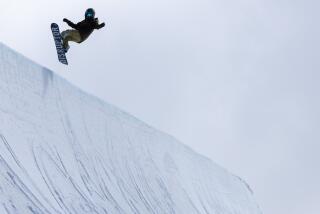Going Where No Ski Resort Brochure Has Gone Before
- Share via
LOVELAND PASS, COLO. — It was finally spring, a fine Sunday morning with blue sky, a few fresh inches of snow and the sun beginning to warm the thin air.
I’ve skied for almost 20 years and still like to take it easy. But my friend coaxed me into a few runs down the ungroomed slopes on the fringes of the Loveland Basin Ski Area, a tough run that requires aggressive tactics.
I struggled down the first run. On the second, I’d almost found my stride. By the third, I should have had it. Instead, I caught an edge of a ski in the sticky snow and pitched head over heels to the accompaniment of a popping sound in my knee.
“Are you OK?” asked my friend.
How many times have I heard that phrase as I lay in some awkward, prone position in the snow? And how many times have I responded cheerily, “Yeah, I’m OK. Thanks.”
Not this time.
“No. I think I hurt my knee,” I groaned. “Get help.”
Two Ski Patrollers were there within a minute, probably fully aware that the likes of me were going to be splattered all over this side of the mountain as the snow “set up.” (New snow stays powdery only in very cold conditions, so in the spring sun it settles into a consistency skiers liken to wet cement.)
Within moments, the patrollers assessed my injury, packed snow around my knee and lifted me into a toboggan.
I was nervous enough about being taken down tied to a toboggan. Then my companion said, “I don’t want to ski down The Face, so I’ll ride the lift back up, cross over to an easier run and meet you at the bottom.”
The Face. I’d heard about it. Narrow. Perpendicular. I’d never skied The Face, and I hadn’t planned to be on it today. But the terrain was too treacherous to get a snowmobile in to take me out on an easier route.
My hair rose under my cap. My first and probably only experience down The Face would be tied down in a toboggan and entirely dependent on the skiing expertise of my escorts.
The Ski Patrollers--Bob Whissen and Jim Flint--were good, really good. Nice easy slide. Nothing too fast. Lots of reassuring queries and progress reports: “You OK, Ann? Any pain? We’ll be down pretty soon.”
They deserve some credit. I wouldn’t ski down this precipice. Neither, apparently, do many others. We saw only one skier on the entire route.
The patrol belayed me down The Face, but the bottom was not the end of the adventure. There was still a tunnel--a cavern of ice and gravel between The Face and the base of the mountain and civilization, which included the Ski Patrol Building where the casualties are taken.
Inside was a scene I haven’t seen in ski resort brochures:
Jeff, 20, of Denver had been on a green (easy) run. When he sailed over a little hill of snow, the front binding ripped out of his snowboard and the board hit him in the chin. Three stitches.
Brenda, 32, San Antonio. Twisted knee.
Gerry, 37, Somerset, N.J., a 30-year veteran of the slopes. Powder skiing when his binding released. A broken ankle and probable torn ligaments.
There were cries of pain from 8-year-old Kevin, and another boy, 5. Kevin had a broken leg.
An elderly woman who had skied for years arrived bruised and shaken. A snowboarder had run into her.
One man was rushed into another room, behind closed doors. I caught a glimpse of him as they carried him by. There was blood all over his face. Later I heard he had knocked out a tooth, lacerated his lip and was in shock. The door was closed for a long time. Eventually his friends came for him, no doubt to take him to a dentist and a doctor for stitches. (The doctors in the Ski Patrol hut assess the severity of injuries and generally send people to their own doctors if it is safe to do so.)
I got to wondering about ski accident statistics and later checked into them.
Ski areas have different injury-reporting methods, and some will not reveal injury rates, according to Steve Over, executive director of the National Ski Patrol System Inc., in Lakewood, Colo. As the primary qualifying and training organization for 27,000 members who provide first aid on the country’s slopes, the group keeps no record of the annual number of injuries, Over said.
There are about three injuries per 1,000 skiers each season within U.S. ski area boundaries, according to Sid Roslund, a spokesman for the United Ski Industry Assn. based in McLean, Va. The association collects its figures from cooperating ski resorts.
Some of these injuries are fatal or catastrophic: During the winter of 1990-’91 there were 28 deaths; 10 injuries resulting in paraplegia and four in quadriplegia; six injuries causing comas, and five serious head injuries. I was definitely luckier than some. A few weeks of physical therapy and I should be fine. I’ll continue to ski, but I’ll stay away from ungroomed slopes in the spring.
More to Read
Sign up for The Wild
We’ll help you find the best places to hike, bike and run, as well as the perfect silent spots for meditation and yoga.
You may occasionally receive promotional content from the Los Angeles Times.






